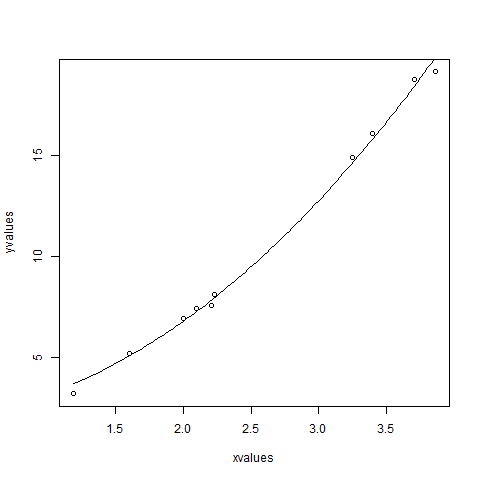R語言非線性最小二乘法
當對真實世界資料建模進行回歸分析時,我們觀察到模型的方程很少是給出線性圖的線性方程。 大多數情況下,現實世界資料模型的方程式涉及更高程度的數學函式,如3或sin函式的指數。 在這種情況下,模型的曲線給出了曲線而不是線性。線性和非線性回歸的目標是調整模型引數的值以找到最接近您的資料的線或曲線。當找到這些值時,我們才能夠準確估計響應變數。
在最小二乘回歸中,我們建立了一個回歸模型,不同點與回歸曲線的垂直距離的平方和之和最小化。 我們通常從定義的模型開始,並假設系數的一些值。 然後應用R中的nls()函式來獲得更準確的值以及置信區間。
語法
在R中建立非線性最小二乘檢驗的基本語法是 -
nls(formula, data, start)
以下是使用的引數的描述 -
- formula - 是包含變數和引數的非線性模型公式。
- data - 是用於評估(計算)公式中的變數的資料影格。
- start - 是起始估計的命名列表或命名數位向量。
範例
我們將考慮一個假設其係數的初始值的非線性模型。 接下來,我們將看到這些假設值的置信區間是多少,以便可以判斷這些值是如何進入模型的。
所以考慮下面這個方程式 -
a = b1*x^2+b2
我們假設初始係數為1和3,並將這些值擬合成nls()函式。
setwd("F:/worksp/R")
xvalues <- c(1.6,2.1,2,2.23,3.71,3.25,3.4,3.86,1.19,2.21)
yvalues <- c(5.19,7.43,6.94,8.11,18.75,14.88,16.06,19.12,3.21,7.58)
# Give the chart file a name.
png(file = "nls.png")
# Plot these values.
plot(xvalues,yvalues)
# Take the assumed values and fit into the model.
model <- nls(yvalues ~ b1*xvalues^2+b2,start = list(b1 = 1,b2 = 3))
# Plot the chart with new data by fitting it to a prediction from 100 data points.
new.data <- data.frame(xvalues = seq(min(xvalues),max(xvalues),len = 100))
lines(new.data$xvalues,predict(model,newdata = new.data))
# Save the file.
dev.off()
# Get the sum of the squared residuals.
print(sum(resid(model)^2))
# Get the confidence intervals on the chosen values of the coefficients.
print(confint(model))
當我們執行上述程式碼時,會產生以下結果 -
[1] 1.081935
Waiting for profiling to be done...
2.5% 97.5%
b1 1.137708 1.253135
b2 1.497364 2.496484
輸出的圖形如下所示 -

我們可以得出結論,b1的值更接近於1,而b2的值更接近於2而不是3。